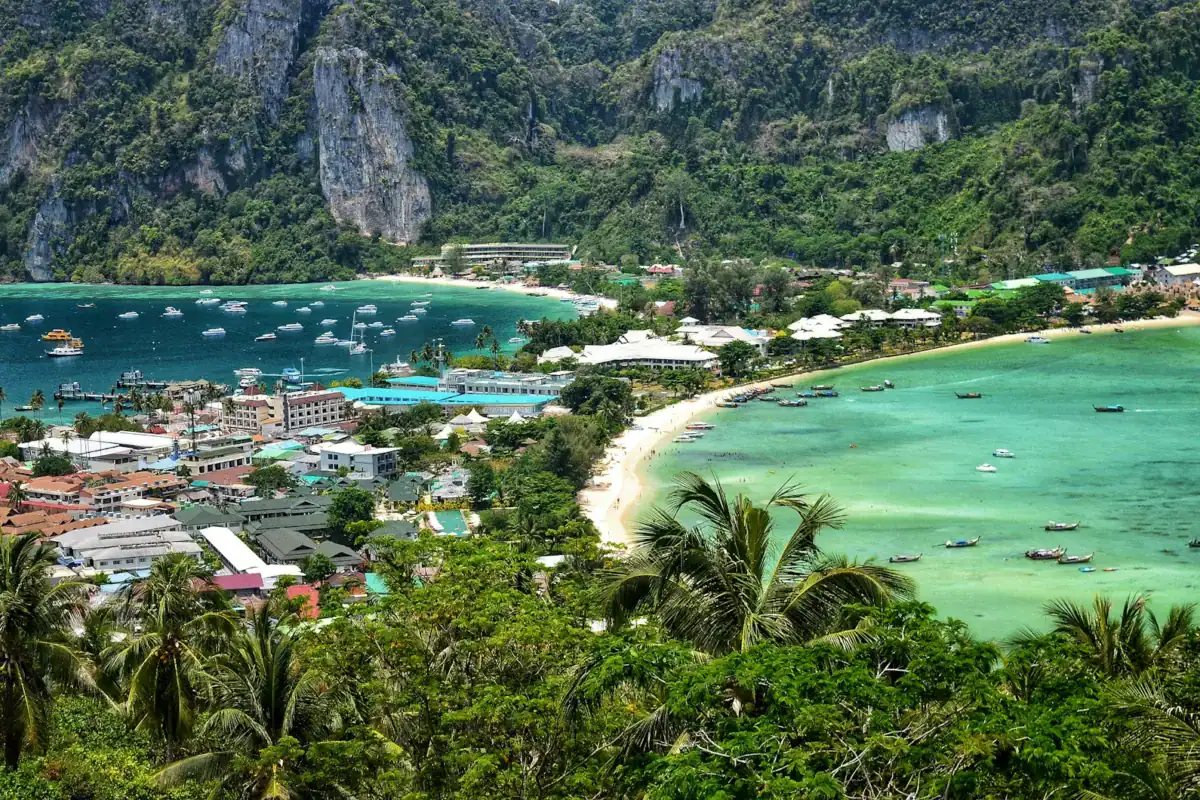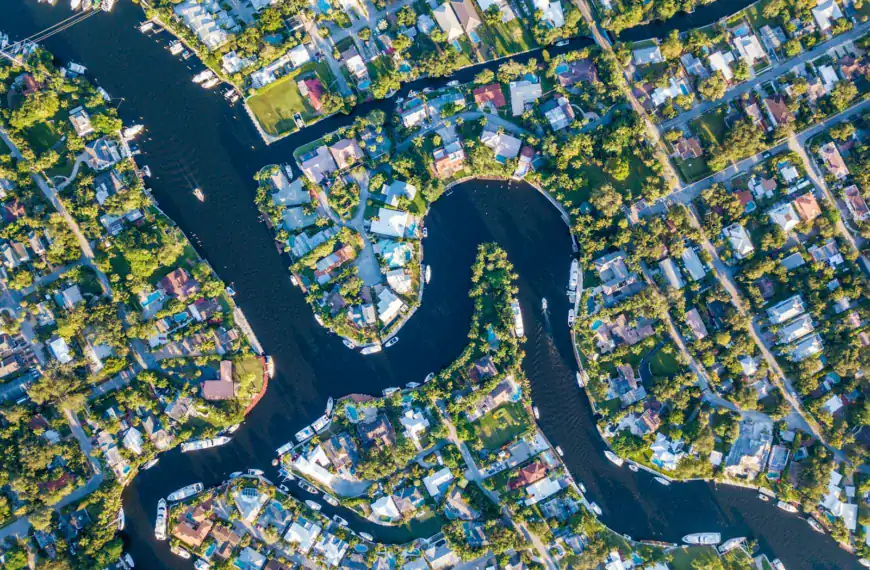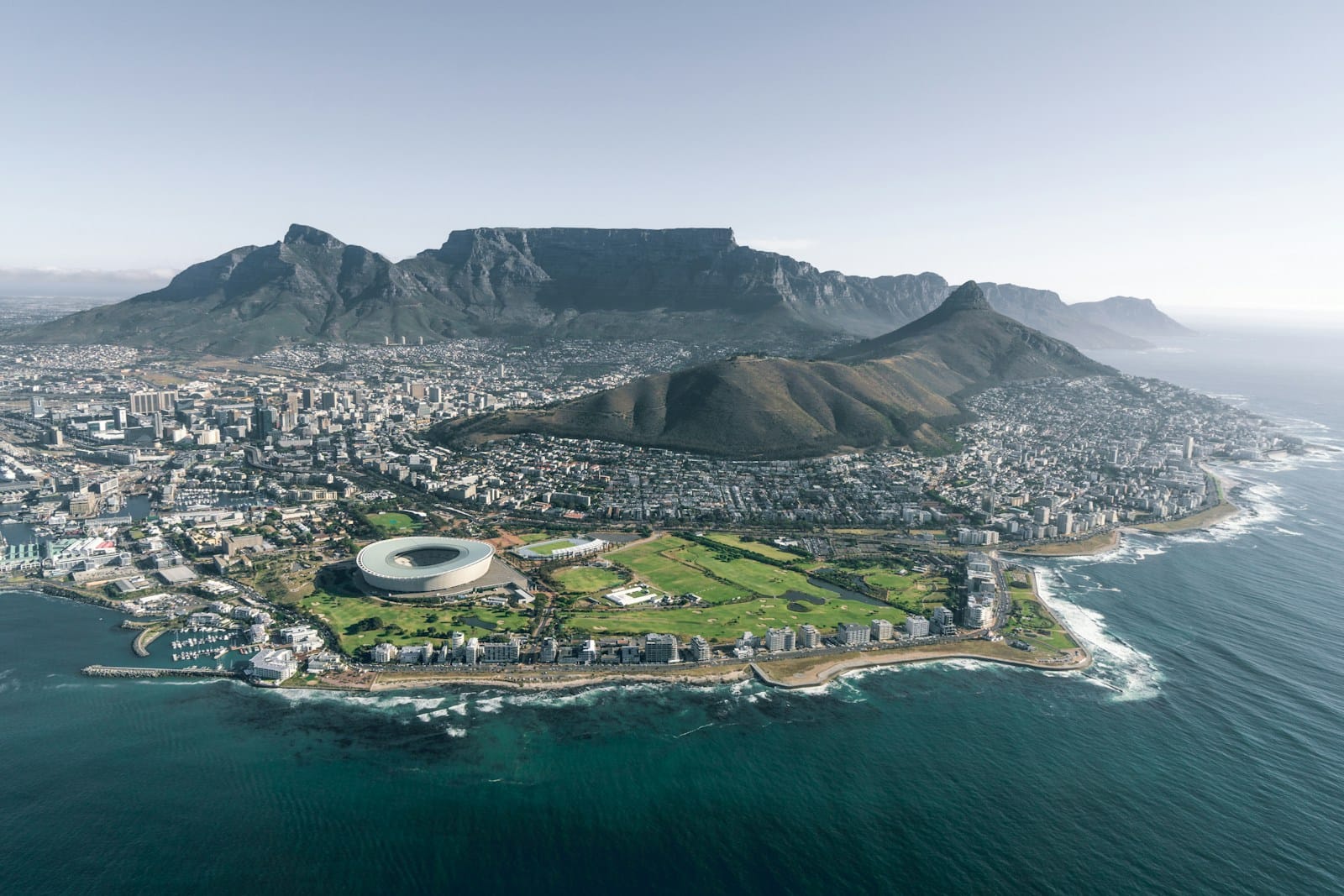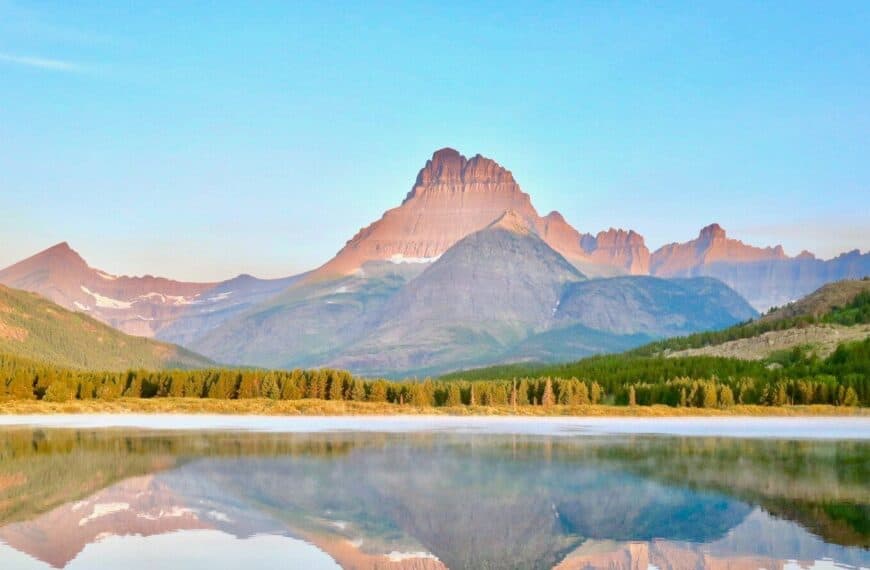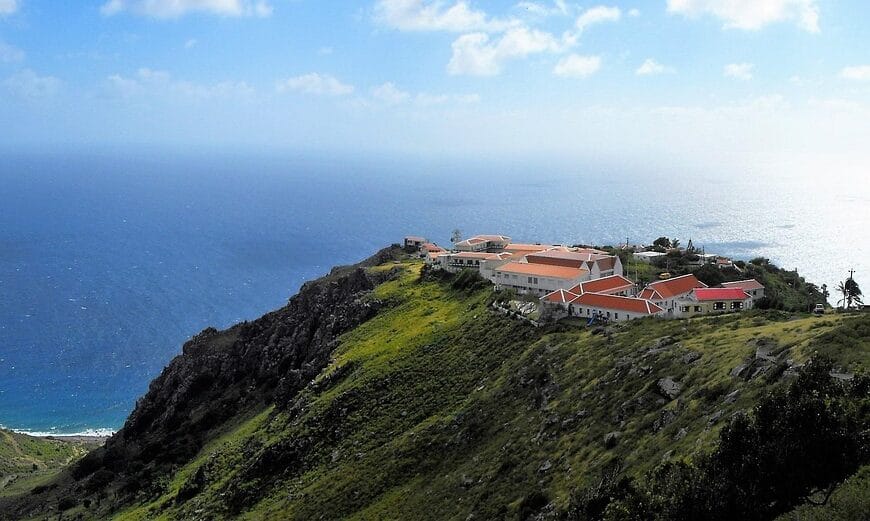Krabi Travel Guide for Islands, Cliffs and Culture
Intro to Krabi Travel Guide
Krabi is Thailand’s wild-beautiful province where jungle-draped limestone cliffs meet milk-blue lagoons and longtail boats idle in water as clear as glass. Base yourself in Ao Nang for easy day trips, kayak beneath cathedral-high karsts in Thalane, and climb to wind-swept viewpoints above Railay’s twin bays. On nearby islands, powder beaches hide coral gardens; inland, hot springs steam under rainforest canopies and emerald pools glow in filtered sun. Use this Krabi travel guide to match your style—adventure or slow days, luxe resorts or beach bungalows—and design an itinerary that flows with the Andaman’s tides.
Exploring Krabi
Ao Nang | Koh Lanta | Koh Phi Phi | Railay Beach | Than Bok Khorani National Park | Thung Teao Forest Natural Park | Tiger Cave Temple | Wat Kaew Korawaram
💡Quick Facts:
Destination: Krabi
Continent: Asia
Country: Thailand
State/Province: Krabi Province
City: Krabi Town (provincial capital)
Area: 4,709 km² (1,818 mi²)
Population: ~460,000 (province)
Density: ~98 people per km²
Founded: Dates back to prehistoric settlements; modern Krabi town grew as a trading port in the 19th century
Regions/Subregions: Ao Nang, Railay, Koh Phi Phi (part of Krabi province), Koh Lanta, Krabi Town, Klong Muang
Official & Regional Languages: Thai (official); English widely spoken in tourism; Southern Thai dialect common
Currency: Thai Baht (THB, ฿)
Time Zone(s): Indochina Time (UTC+7, no daylight saving)
Airports: Krabi International Airport (KBV); nearby Phuket International (HKT ~150 km)
Climate: Tropical monsoon – hot, humid; dry season Nov–Apr, wet season May–Oct
Known For: Limestone cliffs, Railay Beach, Phi Phi Islands, kayaking, diving, island-hopping
🛂Arrival Info:
Visa Policy: Visa-free or visa-on-arrival for 60+ countries (U.S., EU, UK, Australia)
Visa Required: Some nationalities need visa in advance
Visa on Arrival: 15–30 days depending on nationality
Max Tourist Stay: 30–60 days (extendable)
Onward Travel: Proof of onward/return ticket may be requested
Immigration Authority: Thai Immigration Bureau
🏥Health Info:
Vaccines Required: None for entry
Vaccines Recommended: Routine immunizations, Hepatitis A, Typhoid, Japanese Encephalitis (for rural stays)
Health Risks: Dengue, Zika, malaria (rare, rural borders); dehydration and sun exposure risks
Hospitals: Krabi Hospital (Krabi Town), international hospitals in Ao Nang and Phuket
Insurance: Strongly advised, including medical evacuation
Emergency Number: 1669 (ambulance), 191 (police)
🚑 Check travel insurance options for travel emergencies, delays, and medical needs abroad — Get coverage here
💉 Stay Informed with Official Updates: WHO – International Travel & Health | CDC – Travel health updates
🚨Travel Advisory:
Safety Level: Tourist zones generally safe; petty theft and scams possible
Petty Crime: Bag snatching and overcharging (taxis, tours) in Ao Nang and Phi Phi
Natural Risks: Rip currents, monsoon flooding, tropical storms May–Oct
🌍Track Real-Time Official Updates: US Travel Advisory | UK Foreign Travel Advice | Government of Canada | NZ SafeTravel
🥳Holidays:
New Year’s Day: Jan 1
Songkran Festival: Apr 13–15 (Thai New Year)
King Maha Vajiralongkorn’s Birthday: Jul 28
Queen Mother’s Birthday: Aug 12
Chulalongkorn Day: Oct 23
Christmas (in tourist areas): Dec 25
New Year’s Eve: Dec 31
(Local: Krabi Boek Fa Andaman Festival (Nov), Loi Krathong (Nov), Rock and Fire Festival at Railay Beach)
💰Visitor Info:
Currency: Thai Baht (THB, ฿)
Cards & ATMs: Widely accepted in tourist towns; cash preferred on smaller islands
Tipping: Not obligatory; rounding up appreciated; 10% in tourist restaurants
Tourist Taxes: Hotel tax may apply; ferry tickets include small fees
Average Budget: $40–70/day (budget), $80–150/day (mid-range), $200+ (luxury)
🛫Airports:
Krabi International (KBV): Main entry point; domestic and some international flights (China, Singapore, Malaysia)
Phuket International (HKT): Larger hub ~2–3 hrs away by car/ferry
Connections: Daily flights from Bangkok (BKK, DMK), Chiang Mai, Kuala Lumpur, Singapore
🧳 Delayed or canceled flight? Check if you’re eligible for compensation
🚍Transport:
Local Transit: Songthaews (pickup trucks), tuk-tuks, taxis, Grab in Krabi Town/Ao Nang
Boats/Ferries: Regular services to Phi Phi Islands, Koh Lanta, Phuket
Driving Laws: Left-hand traffic; scooters widely rented but risky; IDP recommended
Buses: Intercity buses link Krabi to Bangkok, Surat Thani, Phuket
🚗 Book reliable airport transfers and in-city rides in advance. Reserve your ride here
🛰️Connectivity:
Mobile Networks: AIS, TrueMove H, DTAC
Coverage: Strong in towns and beaches; weaker on remote islands
eSIM Options: Available at KBV airport, 7-Eleven stores, and online providers (Airalo, Holafly)
Public Wi-Fi: Hotels, restaurants, and some beaches
🛜 Stay connected abroad with affordable eSIM data packs. Get your eSIM here
📜Laws & Etiquette:
Drinking Age: 20
Smoking Laws: Prohibited on many beaches; fines apply
Dress Code: Casual at beaches; modest attire in temples and local villages
Etiquette: Respect Buddhist customs; remove shoes before entering temples
LGBTQ+ Safety: Widely accepted in tourist areas; rural areas more conservative
👮Emergency Info:
Emergency Number: 191 (police), 1669 (ambulance)
Tourist Police: Active in Ao Nang and Phi Phi Islands
Tourist Info: Tourism Authority of Thailand
🗺️US/UK Embassies Abroad: US Embassies | UK Embassies
🏛️ Embassy locator tools: Embassies Worldwide
🌞Weather:
Dry Season (Nov–Apr): 24–32°C (75–90°F), sunny, calm seas, ideal for beaches and diving
Rainy Season (May–Oct): 24–30°C (75–86°F), heavy showers, rough seas, fewer tourists
Peak Tourist Season: Dec–Mar with best conditions for tours and island-hopping
Hottest Months: Apr–May, often exceeding 34°C (93°F)
🌦️ Stay prepared—check the weather forecast for your destination — Weather Forecast
Must-Visit Destinations Across Krabi
Krabi Town
A low-rise river city with night markets, riverside promenades, and color-splashed street art. It’s the logistics hub for ferries and vans and the best place to feel local life between island days. Wat Kaew Korawaram crowns the town with white spires and quiet courtyards.
Ao Nang
Krabi’s most convenient base: a beachfront strip of cafés, dive shops, and tour counters with boats fanning out to islands each morning. Evenings bring a mellow promenade glow, oceanfront massages, and easy dining. It’s practical without losing the holiday spirit.
Railay (West, East & Phra Nang)
Accessible only by boat, Railay is a peninsula that feels like an island: turquoise inlets, jungle paths, and limestone walls that climbers dream about. West Railay offers sunset sands; East Railay is mangrove-side and good for budget stays; Phra Nang Beach curves beneath fantastical cliffs and a shrine-filled cave.
Klong Muang & Tubkaek
North of Ao Nang, these quieter beaches face the Hong archipelago and draw honeymooners and families to upscale, low-rise resorts. Expect soft sunsets, glassy morning paddles, and easy access to offshore lagoons.
Thalane (Ao Tha Lane)
A mangrove labyrinth ideal for sea-kayaking under karst towers. Paddling here is silent cinema—egrets stalk in shallows, macaques leap branches, and limestone walls glow amber in late light.
Koh Lanta (Lanta Yai & Noi)
Part of Krabi province yet a world apart: long west-coast beaches and bamboo-shaded roads, with sunset bars and barefoot dinners. Lanta Old Town’s stilt houses face a horizon stitched with islands; inland, national-park trails lead to waterfalls.
Koh Poda & Chicken Island (Koh Gai)
Day-trip darlings for white sand, shallow reef snorkeling, and that photogenic sandbar at low tide. Go early or on a small-group boat to get them at their quietest.
Hong Islands (Mu Koh Hong)
A clutch of cloistered lagoons with water the color of blown glass. Paddle through natural doorways, then float beneath ringed walls where jungle meets sea.
Emerald Pool & Hot Springs (Khlong Thom)
Jungle-sheltered mineral pools with water the color of green bottle glass. Hike boardwalks through a lowland rainforest, soak in warm cascades, and listen to cicadas at dusk.
Tiger Cave Temple (Wat Tham Suea)
A 1,237-step climb to a hilltop Buddha and a rim-of-the-world panorama—limestone ranges, palm valleys, and bright slivers of sea. Arrive at dawn or late day for cooler air and gentler light.
Which Part of Krabi Fits Your Style?
- For first-timers & convenience: Ao Nang balances boat access, dining, and a gentle nightlife. From here, island day trips are as simple as walking to the pier after breakfast.
- For beach-and-cliffs drama: Railay gives you two perfect bays, a cave-framed beach, and footpaths everywhere—no cars, just sandals and sea breezes.
- For quiet luxury: Klong Muang/Tubkaek pair roomy sands with refined resorts and front-row seats to Hong’s jade-ringed islets.
- For slow travel: Koh Lanta stretches time—empty morning beaches, bamboo cafés, and back-road scooter rambles between tiny coves and local markets.
- For eco-adventure: Thalane kayaking, Hong lagoons, and inland Emerald Pool/Hot Springs let you mix gentle paddles with rainforest walks.
- For climbers & active travelers: Railay and Phra Nang offer classic routes, deep-water soloing in season, and sunset wall sessions that feel like film scenes.
Natural Highlights of Krabi
- Phra Nang Cave & Beach: Where golden sand kisses a cliff festooned with stalactites and a cave shrine lined with wooden votives. Snorkel the headlands, then glide back as the wall turns rose in late sun.
- Hong Lagoon: A ring-walled lagoon reachable through a rocky keyhole; inside, the water blushes turquoise and the echoes make whispers feel loud. Kayaks let you linger where speedboats can’t.
- Than Bok Khorani National Park: Rainforest pools the color of green tea, plus short trails under dipterocarp canopy. Pack sandals you don’t mind getting wet; roots cross paths like sculpture.
- Mu Koh Poda Marine Area: A scatter of sand-ringed islets with easy snorkeling and picnic-friendly beaches; watch for parrotfish bites on coral and schools of glass fish in the shallows.
- Thung Teao Forest Natural Park (Emerald Pool): Elevated walkways over peat swamp and karst springs. Early morning is cinematic—dragonflies hover like sparks over mirror-still water.
- Khao Ngon Nak (Dragon Crest): A jungle climb to a brink-of-the-world ledge above Tubkaek. Dawn hikers catch sea mist pooling between island silhouettes.
Cultural & Historic Landmarks in Krabi
- Wat Kaew Korawaram (Krabi Town): White-washed stairways flanked by nagas lead to a hilltop ordination hall; inside, murals and quiet corners offer a cool respite from the market’s buzz.
- Wat Tham Suea (Tiger Cave Temple): Caves, forest, and a sky-platform shrine. The climb is a rite of passage; the view, a reward that makes knees forget.
- Krabi Night Markets: Food-first culture—skewers, roti, grilled river prawns—plus musicians and artists. Come hungry; leave with coconut pancakes and a pocketful of new cravings.
- Lanta Old Town: Wooden houses on stilts, Chinese shrines, and sea-air verandas that creak in the tide. Cafés look across to a patchwork of islands where longtails stitch the horizon.
Local Flavors, Arts, and Regional Experiences
- Southern Thai Plates: Expect heat, turmeric, and lime—khao mok gai (southern biryani), khao yum herb salad, and coconut-rich curries that linger like sunshine. Order “phet nit noi” if you want the spice dialed down.
- Seafood Straight from Boats: Pick live crab, prawns, and squid at Rawai-style markets (you’ll find simpler versions around Krabi), then have a nearby kitchen steam, grill, or wok-toss your catch.
- Coffee & Roti Rituals: Breakfast might be kaya-filled roti and strong Thai coffee poured between metal cups to cool. Old Town cafés roast Thai highland beans and sell jars of pandan custard to go.
- Cooking Classes: Market walk, mortar-and-pestle curry paste, then wok magic—pad Thai that actually balances sweet-sour-salty heat, fried morning glory that snaps under garlic.
- Festivals & Live Shows: Loy Krathong lanterns drift on lagoons; Railay hosts climbing gatherings in season; beach bars run acoustic sets under palms when the wind lays down.
Must-Do Experiences in Krabi
- Island-Hopping by Longtail or Speedboat: Stitch Poda, Chicken, and Tup together in a single blue-green day; swim where the sandbar appears at low tide and watch the islands redraw their edges with every swell.
- Railay Rock Climbing: Half-day classes or multi-pitch routes for the skilled—either way, the view is a lesson in why limestone gives you wings. Deep-water soloing adds adrenaline in calm-sea months.
- Thalane Mangrove Kayaking: Paddle in near-silence beneath karst overhangs, drift past macaques and kingfishers, and feel the tide slide you through tree cathedrals.
- Hong Lagoon Kayak & Snorkel: Enter through a notch into a jade bowl, circle mangrove roots like sculpture, then snorkel over sand patches where baby rays kick up puffs of white.
- Jungle-Hot Spring & Emerald Pool Loop: Soak in terraced hot streams under leaves the size of fans, then cool off in a spring that looks lit from within.
- Sunset Cruise with Dinner: Late-day boats thread cliff shadows; decks turn into dining rooms as the sky drains from gold to ink. Swim under stars if the captain drops a ladder.
Trusted operators provide flexible Krabi tours that bring lagoons, temples, and island beaches to life. Add in unique local activities for the ultimate lineup of things to do in Krabi. We may earn a commission if you book through our links — at no extra cost to you.
How to Get Around Krabi
- Longtail & Speedboats: Your “bus network” to islands and Railay. Longtails are atmospheric and fine for short hops; speedboats cut chop on longer runs. Morning departures mean calmer seas and thinner crowds.
- Songthaews & Local Buses: Open-air trucks and minibuses link Krabi Town, Ao Nang, Klong Muang, and markets. They’re cheap, frequent by day, and thin out late; carry small bills and patience.
- Taxis & Ride-Hailing: Official stands post fares; apps improve transparency and reduce haggling. Late-night returns from Railay require arranging boat + land legs in advance.
- Scooter Rentals: Freedom for experienced riders—helmet on, photo any scratches before signing, avoid night rides in rain. Speeds are low but sand on corners surprises even locals.
- Private Driver / Van: Efficient for multi-stop days (hot springs + Emerald Pool + Tiger Cave). Daily rates are reasonable split among friends or family.
- Walking: Railay is footpaths only; Ao Nang’s promenade is pleasant at sunset; Old Town works best early or late when shadows are long.
Best Time to Visit Krabi
- Spring (March–May): Seas are often calm and clear, ideal for island days and snorkeling. Heat builds by afternoon—start early, break for shade, and return to beaches after 3 pm for gold-light swims.
- Summer (June–August): Southwest monsoon brings short, dramatic showers and livelier surf; landscapes turn neon-green. Smaller crowds, softer prices, and moody skies reward photographers and surfers.
- Fall (September–November): Rain persists but eases by late October; waterfalls swell and mangroves brim with life. Smart planners focus on temples, markets, and kayaking with opportunistic beach windows.
- Winter (December–February): Peak blue-sky season: smooth crossings, reliable sun, and full tour schedules. Reserve boats, top restaurants, and railay-side rooms early—holidays book fast.
Sample Itineraries for Krabi
3-Day Itinerary
- Day 1: Settle in Ao Nang; swim before lunch, then longtail to Railay West for a beach afternoon and sunset at Phra Nang. Dine back on the promenade or linger for a lantern-lit meal on the sand.
- Day 2: Four-Islands loop (Poda, Chicken, Tup + Phra Nang): snorkel shallows, walk the sandbar at low tide, picnic beneath a karst wall. Evening massage and seafood grill.
- Day 3: Thalane mangrove kayak at high tide; afternoon in Krabi Town for temples and coffee; finish with a night market feast and riverfront stroll.
5-Day Itinerary
- Day 1: As above—Railay sunset and Phra Nang cave intro.
- Day 2: Hong Islands by small boat; paddle the lagoon, snorkel over white-sand patches, linger on Hong main beach when big boats leave.
- Day 3: Jungle loop—Emerald Pool boardwalk, Hot Springs soak, and a sunset climb (or viewpoint visit) at Tiger Cave Temple if legs agree.
- Day 4: Intro climbing course at Railay or deep-water soloing in calm conditions. Non-climbers take a longtail to hidden coves for swims and naps.
- Day 5: Free day for spa, scooter coastal cafés, or a slow ferry to Koh Lanta if you’re moving on.
7-Day Itinerary
- Day 1: Ao Nang settle-in; Railay + Phra Nang sunset.
- Day 2: Four-Islands snorkeling and sandbar strolls.
- Day 3: Hong Islands lagoon by kayak; beach-bar sunset at Klong Muang.
- Day 4: Jungle trifecta—Emerald Pool, Hot Springs, Tiger Cave Temple; river prawns for dinner in Krabi Town.
- Day 5: Koh Lanta day trip or overnight hop—long west-coast beach walk, Old Town stilts, and a slow seafood lunch over the water.
- Day 6: Thalane sunrise paddle; afternoon beach-club laze at Tubkaek or a coastal café crawl.
- Day 7: Pick your favorite: climb again at Railay, repeat Hong’s lagoon at a different tide, or join a sunset dinner cruise with night swim.
10-Day Itinerary
- Day 1: Land in Krabi; Ao Nang swim, sunset on Railay West, night market snacks.
- Day 2: Four-Islands plus extra time at Poda’s quiet end after the crowds leave.
- Day 3: Hong Islands lagoon by kayak; snorkel Hong’s outer edges; dinner under strings of lights at Klong Muang.
- Day 4: Emerald Pool morning light, Hot Springs soak, and Golden-Hour climb at Tiger Cave Temple.
- Day 5: Railay climbing progression or deep-water solo; non-climbers take a longtail to tiny beaches around the peninsula.
- Day 6: Transfer to Koh Lanta (1–2 hrs); beach nap, lighthouse walk in the national park, sunset BBQ on the sand.
- Day 7: Lanta scooter loop—Kantiang Bay, Mai Kaew caves (optional), Old Town stilt cafés; ferry back or sleep on Lanta again.
- Day 8: Thalane mangrove paddle at high tide; afternoon café crawl in Old Town Krabi; riverside prawns for dinner.
- Day 9: Free flex: second Hong day at a different tide, or long lunch and spa. Optional sunrise hike up Khao Ngon Nak.
- Day 10: Souvenir stop (batik, local coffee, coconut bowls); last swim; airport transfer with salt still in your hair.
Safety & Etiquette in Krabi
- Sea & Weather: Heed red flags; rip currents and boat traffic can be deceptive. Wear reef-safe sunscreen and never stand on coral. Afternoon squalls pass fast—secure phones in dry bags.
- Transport Sense: Scooters for confident riders only; helmets on, lights working, rain plan in pocket. Confirm taxi or boat fares up front and keep small bills for songthaews.
- Temple Manners: Cover shoulders/knees, remove shoes, and speak softly. Don’t point feet at Buddha images; avoid playful selfie poses with sacred objects.
- Wildlife & Operators: Choose elephant-friendly sanctuaries (no riding), avoid animal photo ops, and pick small-group boats with licensed guides and lifejackets.
- Health & Comfort: Hydrate, take shade breaks, and carry electrolytes. For motion sickness, choose larger boats, sit aft and center, and watch the horizon.
Final Planning Tips for Krabi
- Documents & Money: Passport + travel insurance; ATMs are common in towns but scarce on small islets—draw cash before boat days.
- Packing List: Reef shoes, rash guard, quick-dry layers, light scarf for temples, insect repellent, and a compact dry bag for cameras/phones.
- Booking Strategy: In Dec–Feb, pre-book lodging, island trips, and prime dinner slots. In shoulder months, hold key items and keep the rest flexible for weather.
- Connectivity & Apps: Local SIM or eSIM + ride-hailing and offline maps. Save pier meeting points/boat names in notes with screenshots.
- Responsible Travel: Refill bottles where possible, skip single-use straws, and carry trash off tiny beaches—there’s rarely a bin on micro-islets.
Plan Smarter, Travel Better
- Lock in Tide-Sensitive Days: Hong lagoon and sandbar walks change character with the tide; check tables and book those days first. Everything else can flow around them.
- Go Small & Early: Smaller boats reach quieter coves and leave earlier, beating day-fleet swells and queues—worth the modest premium in both experience and photos.
- Split Your Bases: Do Ao Nang (islands) first, then two nights in Railay (cliffs + sunsets) or Tubkaek (quiet luxury) to change the rhythm.
- Midday Retreats: Plan shaded lunches, spa breaks, or naps in the hottest hours; return out for 3–6 pm gold light and thinner crowds.
- Eat with Your Eyes: Pick busy seafood places with icebeds turning over fast; ask what’s freshest and let the chef choose the cooking method—lime-garlic steam or chili-basil stir-fry rarely miss.
Where to Travel After Krabi
- Phuket: Two hours by road or boat links you to a bigger web of flights, beach clubs, and Old Town’s shophouse cafés. Pair Krabi’s wild cliffs with Phuket’s dining scene and day trips to Phang Nga and Similan.
- Koh Lanta: Stay longer on Krabi’s slow-island cousin—west-coast sunsets, jungle trails to waterfalls, and stilt-house lunches over calm water. It’s the antidote to busy bays.
- Khao Sok National Park: A rainforest and limestone lake world away from the coast. Sleep in a floating bungalow, canoe under overhangs, and trade surf for cicada song.
- Trang Islands: Quieter archipelago south of Krabi with sugar-soft beaches and sea caves. Ideal if you crave low-key islands after headline names.
- Koh Yao Noi & Koh Yao Yai: In Phang Nga Bay between Krabi and Phuket, these rural islands blend rice fields, bay-side hammocks, and boutique eco-stays with front-row karst views.
It’s Time to Experience Krabi
Krabi is Andaman drama made easy—sea caves that breathe with the tide, lagoons that glow like blown glass, cliffs that set sunsets on fire. Whether you spend your days paddling through mangroves, roping up warm limestone, or ferry-hopping between powder beaches, the province invites you to slow down and look closer.
Use this Krabi travel guide to chart your days by tides and light—and let Thailand’s wild coast write itself into your memory.

